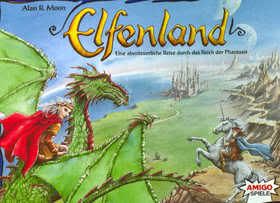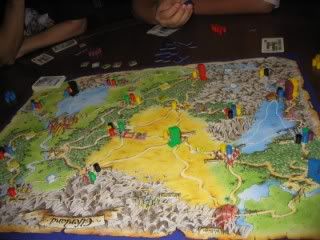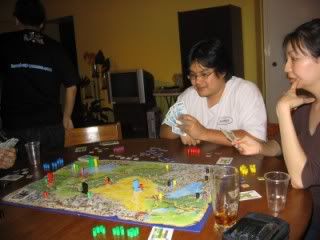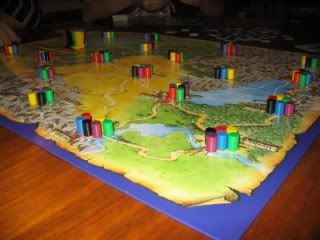
Players take the role of young elves that embark on a coming-of-age ritual. They are to visit as many cities in the Elven kingdom as possible in four seasons, using a variety of transport available to them. The elf that visits the most cities at the end of the game wins.
As I understand it, Elfenland is a simplification of the original Alan Moon design Elfenroads, which had a whole economic system attached to the game. Perhaps the theme made more sense in that context. This component can be restored with the Elfengold expansion, which is out of print and is fairly expensive on the secondary market as of this writing.
Anyway, Elfenland is packaged as a family game, so it has bright graphics and storybook-style illustrations that appeal to children. They’re pretty enough, and many people think the Elfenland board is one of the best ever. (I don’t share that view – the graphic design of Elfenland is ok, but it’s not exceptional.) The components are very nice, as is typical of an Amigo Spiel production. The box is large and linen-finished, with a custom plastic insert with a place for everything. The board is of the large, four fold linen-finished variety. The city markers are small wooden cylinders on six bright colors. The cards are large and linen-finished, always a huge plus in my book. These cards hold up well under heavy use. The tiles are small and thick cardboard markers. Finally, the players’ tokens are large boots, a nice creative touch that’s just marred a bit by the propensity of the boots to fall over once in a while. It’s not really a huge problem though. The rules come in a large-type, full color booklet, and are very clear with illustrated examples. All in all, it’s a superlative package especially if you like the graphics.
The Game
The players begin the in the large castle towards the eastern section of the board. From here, they need to visit as many of the twenty cities on the board as possible in four seasons. Cities are connected by roads through various terrains, and by rivers or lakes.

There are six different types of transportation available. These are depicted on transportation cards, which are shuffled and dealt out to the players randomly to begin the turn. The types of transport are amusing, ranging from a pig, to a troll-drawn wagon, to traditional fantasy steeds like the Unicorn and the Dragon.
This is the part that doesn’t really work for me. What is this, some kind of random ticket-issuing machine? It jolts the game out of theme and emphasizes that this part of the game is random.
Once the cards are dealt, the players draft transport tiles. These tiles depict the same modes of transport as the cards. All the tiles are mixed up face down, then five tiles are turned up to serve as the draft row. First, players each take a random face down tile each, to serve as their “secret tile”. These are not revealed until played. Then, players draft tiles from the drafting row (new tiles are turned up as open ones are drafted, so each player always has a choice from five) until each has three open tiles. (Players may opt to take a face down tile, but must turn it up as it is drafted.) In addition, each player is given on “obstacle tile” – it’s the only one each player gets for the whole game.
Again, this part of the game doesn’t work for me. If the players are the elves, what are they doing determining what sort of transport is available all over the kingdom? It’s really gamey, and again jolts the players out of the theme.
Once each player has four transport tiles (one hidden and three open), these tiles are then played onto the board. In turn order, each player places a transport tile onto a route on the board. Each route may only accommodate one transport tile, which will determine what cards are necessary to traverse that route this turn. Thus, players should draft and play tiles based on what cards they were dealt. Players may play as few or as many tiles as they like, but they may only carry over a single tile into the next turn. Any excess tiles kept are discarded.
This part of the game is the major part of the turn angst. Will you be able to put your transport tiles on the route that you picked out? Will some other player gum up your plans by playing another type or transport that he has because he’s also heading that way? Or even worse, another player could actively block you by playing a non-optimal (two card) transport type right on your route, probably forcing you to an alternative route. This is the best part of the game, but again it’s gamey and out of theme.
When all the players have passed on playing tiles in succession, the elves begin traveling. In turn order, players play their travel cards to move across the map. The travel guide card indicates how many cards of each mode of transport are needed to move your elf down that route (from one to two cards). If a player does not have a card of cards matching the required transport, he may play any three cards to form a “caravan” to take him down that route. Needless to say, this is a huge bite out of a player’s eight-card hand. An obstacle adds one identical card to the travel requirement. Caravan travel over a route with an obstacle requires four cards of any kind.

In each city, a cylinder of the player’s color is placed at the beginning of the game. As players visit each city, they collect the cylinder of their color to indicate that they have visited that city. Visiting a city a second time has no further benefit.
It’s too bad that this part of the game, the heart of the theme, is an afterthought to the placement of the transport tiles. Sure, there’s some emotion here if your plans were wrecked, or satisfaction at being able to visit seven cities in one turn, but it’s all anticlimactic. You already knew what you’d be able to do when the transport tiles were placed.
The elves move from city to city until they are unable or unwilling to move any further. Each player takes his whole movement in one go. Once all players have moved, the starting player card is passed to the left and a new turn begins. Any leftover travel cards are carried over into the next turn. To start the new turn, players’ hands are refreshed back up to eight cards, the transport tiles are all removed from the board and returned to the face down pool, and players draft one secret tile and three open tiles again.
Four turns are played. At the end of the four turns, the player who had visited the most cities wins! In the event of a tie, the player with the most travel cards remaining in hand wins!
Strategy
Elfenland is a simple game of route planning, tile drafting and route claiming. It’s got a bit of randomness in the card and tile draws, and it has a touch of chaos in the route claiming. However, it’s a pretty good introductory game for players new to German games.
Most groups would start out playing Elfenland as a game of optimization. Try to draft tiles that match the cards you get, then try to put the tiles on the route that you plan to take. Ensure that you have a plan B since another player may put a travel tile different from what you planned on the route you planned to take. Played this way, it’s a relaxing game or activity, especially when played with just three or four players. The obstacle tiles may be dispensed with in a game with this mood.
More advanced players will add the element of blocking. In addition to claiming a route with the mode of transport you want, more discerning players will also sniff out the likely routes their opponents will take and play sub-optimal tiles (the ones that require two cards) into those routes. The obstacles are important in thwarting attempts to visit up to seven cities per turn. Finally, it would be rather boring to play with anything less than five players. Elfenland with six players is best, since it ensures maximum competition for routes, and also maximizes the blocking factor of the whole game.

Reviewer’s Tilt
Elfenland is an ok game to bring out for new German game players. It’s a good introduction to resource drafting and planning in general. It’s also attractive, and that’s always a plus when recruiting newbies. Don’t play with more than four players in this mode, and dispense with the obstacles. These kinds of games should be around the 60 to 90 minute range.
With regular gamers, six players is the only way to play Elfenland. However, that also stretches the game time to 120+ minutes, which is pretty long for a game without much meat on it. The game also gets repetitive after a couple of plays, and the randomness of the cards and tiles can take a lot of fun out of the game.
I find it disappointing that such a nice looking package fails so badly in the theme department. I was expecting a fun theme where players can get into the traveling elf mood. Unfortunately, the game is more about providing the transportation for the elves, rather than the elves’ journey. The theme, sadly, does not work.
If you play with a lot of casual gamers, then Elfenland is definitely a game that you should consider. Despite the head-scratcher of a theme, it’s light and pretty and plays at a fairly good clip with up to four players. If you like your games to have some depth and strategy to them, then Elfenland isn’t going to do that for you, so you should look elsewhere.
No comments:
Post a Comment